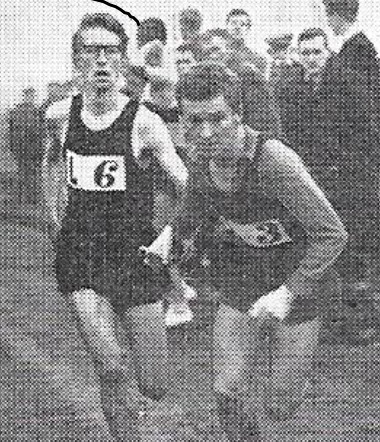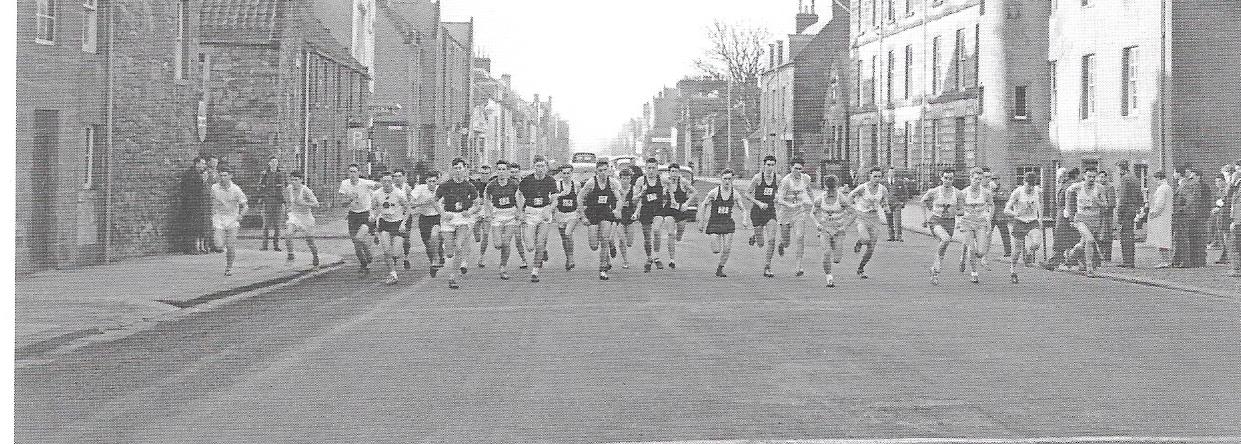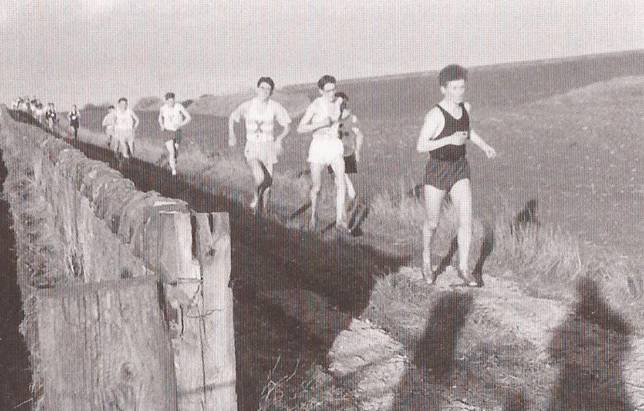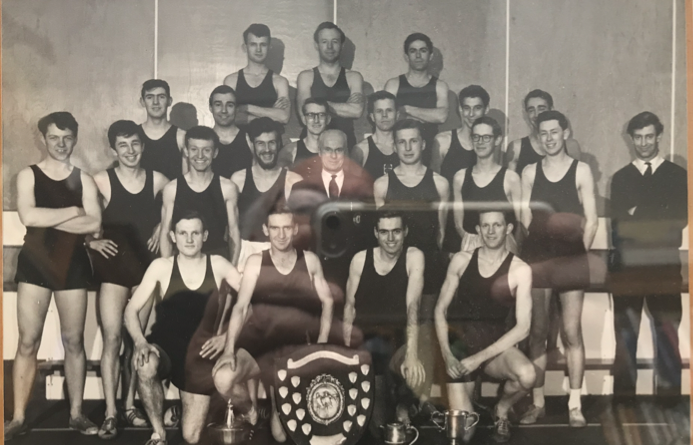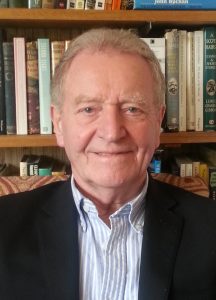The story of the great Glasgow University cross-country team of the 1960’s would not be complete without telling about Doug Gifford: TDG Gifford sounded more like an amateur cricket player of the 1960’s but he was a talented and hard running athlete that any club in the land would have been glad to have as a representative. He is pictured above (L3) taking the baton from Cameron Shepherd in the Edinburgh to Glasgow relay race where he had many a good run. That he was a naturally gifted runner was never in doubt but he confined his endeavours to cross-country and road running. There is no record of him running in club, university, inter-varsity, district or national championships on the track at all. He first appears in the record books on 26th January 1957 when he ran in the Midland District Championships as a Youth (Under 17) where he was 8th and the sole representative of his club, Garscube Harriers. A year later, 1st March 1958 he ran in the National Cross-Country Championships at Hamilton, again in the U17 age group, for Garscube Harriers where he finished third – six seconds behind J Linaker with an Anglo from South Shields winning the race. At this point he left Hillhead High School and went up to Glasgow University where he continued to run and his performances improved immensely with every year that went by.
The winter season starts in October and on the very first day of November Freshman Gifford ran on the third stage of the Midland District Relay with the others being Horn, Woodcock and Johnstone. The team was 12th but he was in the first team right from the start. Two weeks later he ran in his first Edinburgh to Glasgow eight stage relay race for the Hares & Hounds. He ran on the first stage of this invitation only event and handed over in 13th place to another who would be one of the teams outstanding runners over the next few years, Callum Laing. 1959 started with the traditional Nigel Barge Road Race at Maryhill and Gifford finished 22nd and first University runner with Stan Horn in 30th place. On 10 January 1959 a trial was held over an icy and treacherous seven mile trail from Garscadden. which Gifford won easily in 38min 34sec. There was a match against St Andrews University on 21st January in dull wet conditions. The University history tells us that : “as soon as open country was reached conditions underfoot were very treacherous for the runners, with the thaw having come too late and the overlying water merely concealing the ice below. Stan Horn won the race in 37 min 18 sec, with Jim Bogan second (37 min 21 sec) and Douglas Gifford third (37 min 25 sec). In the Team competition Glasgow won easily with 30 points. St Andrew’s scored 72 and Aberdeen 87. “
Gifford, along with Callum Laing, was injured at the time of the Scottish Universities championship and did not run that year. Then came the Midland District Championships where Jim Bogan finished first in the Youths’ Race, and Douglas Gifford was the second Junior home. On 28th February the climax of the cross country season came in the form of the National Championships at Hamilton. Gifford was 25th in Junior race and first GU runner. The team finished 5th.
Gifford was one of ten runners presented with first team colours at the AGM at the end of 1958-59 and he was also elected Secretary/Treasurer at the same meeting.
Start of 1960 Scottish Universities Championship in St Andrews
In his review of the 1959-60 season, the team captain (Nick Rogers) spoke about the mixed fortunes of the Club during the previous season. “The First Team Trial had seen six men beat the Blue’s standard of 38 minutes over the Garscadden course (later that night this was lowered to 37min 30sec). Then a Glasgow Eight “hammered” Queen’s University (Belfast) by maximum points over the Garscadden course. The Hares and Hounds had finished 10th in the Midland District Relay. “Edinburgh, our arch enemies, were also soundly trounced at last after 10 years, Gifford, Bogan, Horn and Hunter finishing in that order before the first Edinburgh man” On this occasion Douglas Gifford also set a new course record of 36min 51sec over the Garscadden course.”
In open competition, a team of Rogers, Bogan, Gifford and Hartley was tenth in the Midland District Relay on the first Saturday in November and then on 21st November Doug Gifford found himself running the notoriously difficult second stage of the Edinburgh to Glasgow relay. Difficult because of its six miles of undulating road but more difficult because it was the leg where each and every one of the invited teams put out their best runner. Not surprisingly the young Gifford, who had taken over from Jim Bogan in ninth dropped down to 13th position. The next major championship was on 23rd January 1960 and it was the Midland District event. He finished 31st and top Hares and Hounds counter for the team that finished ninth.
Having been Secretary of the Hares and Hounds in 1958-59, Doug was also elected Captain for season 1959-60 and led the team into the national universities cross country championships. They were held at St Andrews on 5th February in 1960 and the race is described by Donald Macgregor in his book “Running My Life” as follows:
“It was quite sunny and drier underfoot than the week before. The individual and team struggle was intense along the Kinkell Braes, over to the A917 Crail Road, and up the big hill with its ‘plough’. St Andrews were 12 points ahead with 2 miles to go, as we plummeted down from Lochend farm track over stubble fields with the whole magnificent vista of the city and its towers laid out before us. Alas for our hopes! The Glasgow middle counters gradually moved up the field. The two best Glasgow runners, Douglas Gifford and Jim Bogan, and I had broken away from the rest quite early on. We stayed together through the streets of the new town and were still together going up Dyers Brae into narrow Abbey Street and over South Street into South Castle Street. It was only over the last 300 yards that Gifford and Bogan were able to break away from me to take the first two places for Glasgow, with five seconds covering the first three. David Jeffrey followed me home in fourth. Glasgow also took the team medals but there were only 7 points in it. “
Exactly one month later, on 5th March, the team headed for Hamilton for the National Cross-Country Championships. The Junior team performed well and was placed third at the finish with the counting runners being Bogan 14th, Hunter 16th, Gifford 27th and Hartley 28.
At the end of the season Gifford was not only awarded club first team colours, but with Stuart Hunter, awarded a Blue.
Leading on the way to victory in the Scottish Universities cross-country championships in 1960
Both photographs from Donald Macgregor’s “Running My Life”
The University season started with their Irish tour which had been excellent; the Hares and Hounds having been treated exceptionally well by their hosts. Thirty four runners had taken part in the six+ mile race in Belfast where Calum Laing was first in 34min 53sec, Douglas Gifford second in 34min 55sec, John Gray third in 35min 13sec, Stuart Hunter fourth in 35min 26sec and Jim Bogan fifth in 36min 00sec. The team went on to a match against Trinity College in Dublin and Calum Laing also led his Team home in the race. In other inter-University competition St Andrew’s and Aberdeen had been beaten comparatively easily by the Hares and Hounds. These results are noted as they indicated that the Hares & Hounds were of a strength to compete seriously in Scottish athletics. The Junior team had been third in the National the previous season and they were all now of an age to take on their elders. This was shown on 19th November when the team won third place medals in the Edinburgh to Glasgow Relay.
Gifford ran on the longest stage in the race – the seven miles of the sixth stage where he took over in fourth place from J Gray and handed over to Dick Hartley in fourth place. Hartley picked up one place and Tor Denstad took the team home in third. It was the first University team to win medals in the event.
21/1/62: In the Midland District Championships held at the Strathleven Estate in Renton, Gifford was 32nd and fifth counter for the club team which finished 10th. It was then on to the National on 4th March where the Junior Team went one better than the previous year and came away with the silver medals. Douglas Gifford led the team home in 9th with the others being Bogan 13th, Baillie 32nd, and Shepherd 33rd.
Gifford had missed several races that winter but his running was such that he was again awarded first team colours, one of nine to be so honoured.
GU 1960/61 team photograph: Gifford is third left in second row, standing directly above the kneeling Callum Laing
In 1961, the top Glasgow University men missed the District Relays at Stirling because they had a match at Garscadden: Glasgow, against St Andrews University which they won by 26 points to 56, providing six of the top seven runners. Laing won the individual race by 68 seconds from Judge of St Andrews with Baillie, Hartley, Bogan, Gifford and McPhail in that order competing the team.
The Edinburgh to Glasgow in 1961 was held on the 18th November and Gifford was again on the long, downhill, sixth stage. While all stages of this race were contested by quality runners, stages two and six were especially hard. Gifford held his place, taking over sixth and handing over sixth for the team which finished eighth. Into the new year and on 20th January the Midland District championship was held at Strathleven. With 130 runners, Laing was first team runner home in 11th place with Gifford 16th, and Shepherd 25th for the team that was fourth – only four points behind the third team , Bellahouston Harriers. The remaining major championship was the national, again at Hamilton on 3rd March. Gifford was 27th of the 190 finishers in his first run in the senior race and second scorer behind Calum Laing who had a wonderful run to be third. The team was eighth.. The 3rd March saw the Senior National in which Gifford was 27th in the team, led home by Laing who was 3rd.
In the Minute of the 1962 AGM, the following business was mentioned: “Douglas Gifford then told the meeting that he knew of a cottage near Fort William owned by the Caledonian Canal Trust which could be rented for £15 per annum. He suggested the Hares and Hounds take steps to acquire the cottage as a place for weekend or vacation visits, and as a Training Camp. This idea was enthusiastically received and Douglas Gifford was instructed to go ahead and arrange for the cottage to be rented. (However, as it turned out, Inverness County Council prevented the Hares and Hounds from obtaining use of this cottage. Nevertheless Douglas Gifford reported at the following AGM that the Section had an open and permanent invitation to use the facilities of Lochaber Harriers, and that he had a key to these in his possession). “
Douglas Gifford became a noted academic, a specialist and expert on Scottish literature but this did not happen by accident and at this point in his running career his studies were at a crucial point and were demanding more and more of his attention and his racing programme was slimmer than it had been although the quality was still there.
On 5th November, 1962, Glasgow University beat Loughborugh College by 23-67, a comfortable victory, and Laing, Faulds and Gifford were the first three in the race. This was followed on 10 Nov 62 the University beat Aberdeen, St Andrews and Durham Universities with Faulds 1st in 36:26; with Gifford fourth. GU won by 35 points from Durham, St Andrews and Aberdeen. In the Edinurgh to Glasgow on 17th November he ran the fourth stage. Taking over in second, he handed over in second for the team which finished third and he was third quickest on his stage of the race. His running led to selection for Scottish Universities against the SCCU, a fixture to be held on 15th December. He was unplaced in the race against a very strong Scottish team.
His running for the season seems to have ended here with no appearances in District or National championships.
*
In 1863-64 Gifford was missing from all the major cross-country events but was out again in 1964-65. His first appearance was in the Edinburgh to Glasgow relay where he was back on the sixth stage but the edge was off his running after his ‘time out’. Taking over in 13th, he dropped two places to 15th/ In the Midland District Championships on 16th January he finished in 46th position and was fifth counter in the team which finished fourth and just out of the medals. He did not run in the National Championship at the end of February.
Thereafter he ran in two Edinburgh to Glasgow relays (20/11/65 on 6th when he dropped from 14th to 16th) and 19/11/66 when he improved the team’s position from 17th to 16th on the final stage) and one National (26/2/66 when he was 50th, the team finishing 8th). And that was where his career as a member of the Hares & Hounds seems to have ended. It had been a good one with many excellent times, a Scottish Universities cross-country championship to his credit, University international selection and a major part in many a team success over the country and on the road.
He was part of a really good generation of runners at Glasgow along with Callum Laing, Allan Faulds, Brian Scobie, Jim Bogan and all the rest. It is intriguing to speculate what that group could have done had they been like the Edinburgh University team of the late 60’s and 70s and lived in the same house and trained together.
He went on to great things as an academic. Honorary Senior Research Fellow at the University of Glasgow he has several publications to his name and the Edinburgh Sir Walter Scott Club lists his major achievements as follows:
“Douglas Gifford was formerly Chair of Scottish Literature at the University of Glasgow; he is now Emeritus Professor and Honorary Research Fellow. He has written extensively on Scottish fiction, including James Hogg (1976), and Neil Gunn and Lewis Grassic Gibbon (1983). He edited Scottish Literature; Nineteenth Century, 1988; with Dorothy McMillan he edited A History of Scottish Women’s Writing, and with Sarah Dunnigan and Alan McGillivray, Scottish Literature in English and Scots (2002). He was on The Saltire Society Book Awards Panel from 1982 till 2011, and is presently The Faculty of Advocates Honorary Librarian for Scott’s Library at Abbotsford. He is a Fellow of the Royal society of Edinburgh.”
Respected abroad as well as at home for his academic attainments, he will still be remembered by University runners from all over Scotland affectionately as Dougie Gifford, a really good runner who might have been even better.
